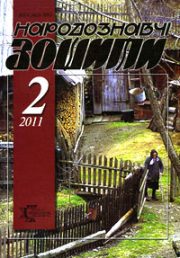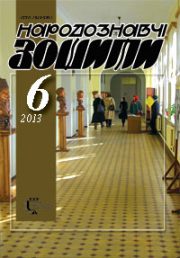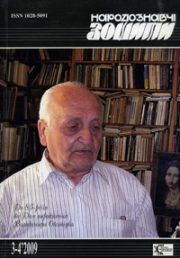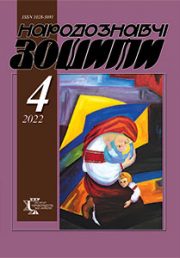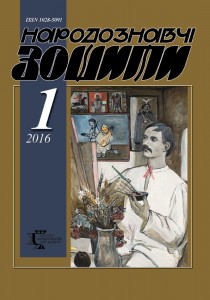
Sorry, this page is under construction…
Roman Kyrchiv The Kharkiv center of ukrainian folkloristics (first half of the XIX ct) P. 3-22
The materials, represented in the article, should be a part of voluminous «History of Ukrainian folkloristics», being prepared to edition in the M. Rylskiy Institute of art study, folkloristics and ethnography of the National academy of sciences of Ukraine. They show general conception, scheme of research structure and operation of plan prospectus of the first volume, namely: pre-romantic and romantic interests by Ukrainian oral and verbal folk art — was entrusted to the author of this article. The primary chapters of this work were published in the magazine «Folk art and ethnography».
Keywords: Ukrainian folklore, romantic folkloristics, Ukrainian national and cultural renaissance, workshop of Izmail Sreznevskiy.
read »
Ulyana Movna The patron saints of ukrainian beekeeping P. 23-29
The paper is the first attempt in domestic ethnology to research the figures of the patron saints of Ukrainian beekeeping, an important role of which found adequate reflection in the folk notions. It was defined that by the way of imposition of existent pre-Christian calendar of celebrating the memorial days of Christian saints in church calendar and its self-receiving of additional connotations, their coincidence with traditional dates of using modes for invoicing bees out of the winter hiding places, and also the imposition and contaminations of several images of saints, memorial days of which matched calendarly, the main patron saints in the process of long forming and assimilation of Christian axiological values in the limits of Christian pantheon, became Saint Alex (man of God, Worm Alex) and the saint miracle workers Zosym and Savatiy.
Keywords: beekeeping, saints, patrons of bees, Christianity, folk notions.
read »
Andrij Temchenko The mythology of the hair in the medical practice of slavs P. 30-37
The article focuses on the mythological ideas of Slavs about the role of hair in the medical practice. Hair is the object over which the magical manipulations were carried out. Its thickness and length should contribute to growth of young shoots, increasing the number of livestock, the birth of children. Attention is paid to the great role of carrying of the hair in order to avoid confusions and twisting. It was forbidden to comb hair in «women day» (Wednesday or Friday), but recommended in a «male day» — Tuesday and Thursday. The important role of other preventive actions is mentioned. Hair must be carefully hided out of the «strange eye», which can be harmful. The witch formed another trouble. She can tie knots, «twist and tie human health». This explains why the methods of conserving hair are similar to inhumation of «sinful» defunct (stone crushing, digging at the crossroads, cindering).
Keywords: hair, magic, taboo, ritual, days of week.
read »
Iryna Ignatenko Creating of human body in the traditional beliefs of ukrainians P. 38-42
The paper, based on the etiological legends and cosmogonic myths, deals with the problem of Ukrainian traditional beliefs, connected with the creating of human body. The author analyses folk notions about the symbolics of nature materials, from which human body was «made»; the reasons of creating people of two genders — man and woman; humans dualistic nature (predisposition to good and evil) etc. It is shown, that besides the biblical plot, apocrypha had a great influence on forming the beliefs, and it caused the creating of original and ethnically picturesque legends.
Keywords: body, cosmogony, myths, legends, beliefs.
read »
Olena Serebryakova Divination practice of «eavesdropping» of alien talks in the ukrainian tradition P. 43-48
One of the types of sound divinations – «eavesdropping» of the talks near the windows of neighboring houses, is analyzed in the paper. Such divination practice was traditionally performed during the name day of Andrew and Christmas and New Year period (Christmas Eve, Melanka). As a result, the author showed the connection between this practice and the ancestor worship. Actional and verbal aspects of divinations, its symbolics, semantics, local versions, specificity of the Ukrainian divinations.
Keywords: divination practice / ritual acts (divinations, sortilege), window, «eavesdropping», housewife, host, «oracular» words, wedding, girlhood.
read »
Roman Radovych The polissyan «klit»: constructive features and dynamics of its functional using P. 49-58
«Klit» (cold pantry) — one of the main household buildings of the Polissyan yard, is reviewed in the paper. A characteristic of its specificity, constructive features and functional purpose are given. According to the sources, in the XIX — first half of the XX ct. «klit» could have household function, as well as the function of seasonal (summer) dwelling. The analyses of the sources gave the possibility for the author to state, that the similar functions (summer bedroom) were peculiar for the building with such a name in the XVI ct., as well as in the period of Kievan Rus’ (X—XI ct.).
Keywords: Polissyan yard, cold pantry, «klit», seasonal dwelling, semi-dugout dwelling, heater.
read »
Tetyana Kutsyr Female shirts of Opillya: typology and artistic features P. 59-73
In this paper the artistic features, typology, imagery of femaleshirts of Opillia are discussed. The main attention has been paid to the shirt’s fabrics, cut’s types and its variety, ways of laying ornamental patterns and their significance in the overall structure of the Opillya’s female clothing complex.
Keywords: shirt, embroidery, fabric, material, décor, ornament, structure, pattern.
read »
Vasyl Kotsan Traditional female half-length clothes of ukrainians in Transcarpathia (ХІХ — first half of the XX ct.) P. 74-91
The article is devoted to the research of traditional female half-length clothes of Ukrainians in Transcarpathia ХІХ — first half of the XX ct. On the base of the field, archive and literary sources, museum collections a few important aspects are analyzed on the probed subject: material and methods of making (cutting out), artistic features (finishing), methods of dressing and functional setting (workaday, festive, ceremonial) of female half-length clothes. The evolution of cutting out went from the unsewn forms to sewn together. Artistic expressiveness to both workaday and festive clothes, was given by embroidery, factory ribbons, machine guy-sutures, decorated by the bead. The methods of dressing the female half-length clothes had its specificity: sequence and correlation of skirt, apron and belt. The study of the functional setting of different elements enabled to find out their simplicity, festivity and symbolics.
Keywords: female half-length dress, skirt, apron, zapasky, belt, cutting out, homespun linen, factory matter, finishing, embroidery, factory ribbons, machine guy-sutures, lace.
read »
Romana Motyl Ukrainian artistic ceramics in the middle of XX-th — EARLY XXI-st century: historiography and methodology of the research P. 92-98
The article analyzes historiography, highlighting the phenomenon of Ukrainian artistic ceramics in the middle of XX-th — early XXI-st century. Pursuance of the research in this area is argued. The methodology of the research is represented.
Keywords: historiography, phenomenon, Ukrainian artistic ceramics, research, methodology.
read »
Olena Shcherban The ceramics through the prism of scientific investigations of Mykola Fedorovych Sumtsov P. 99-104
The information about using of ceramics by Ukrainians, adduced in the works of famous Ukrainian ethnographer Mykola Sumtsov, is systematized. The aspects, which were firstly mentioned in his investigations, are selected. A conclusion was made, that Sumtsov didn’t researched ceramics in the context of nutrition culture, but especially in the sphere of rituality. He fixed unique facts, showed changes concerning ritual ceramics and pitchers with criss-crosses, demonstrated changes in the pottery of Okhtyrskyy county in the last quarter of XIX — beginning of the XX century.
Keywords: Mykola Sumtsov, Kharkivshchyna, ceramics, culture of nutrition, cups-triychatky.
read »
Vasyl Syvak Establishing the interior of the folk dwelling in Transcarpathian part of Lemkivshchyna P. 105-122
A paper deals with a problem of establishing the interior of the folk dwelling in Transcarpathian part of Lemkivshchyna. A main part is based on the field ethnographic investigations, carried out in the villages of Velykiy Bereznyy and Perechyn regions in Transcarpathia.
Keywords: Ukrainian Carpathians, Transcarpathian part of Lemkivshchyna, establishing, interior, folk furniture.
read »
Marianna Movna The guide-books of Ukrainian Carpathian mountains of the second half of the XIX — beginning of the XX century: historical view P. 123-135
This article is the first attempt in Ukrainian historiography to research the history of the guide-books of Carpathian Mountains of the second half of the XIX — beginning of the XX-century. The content of the most noticeable tourist guide-books of the Carpathians is analyzed in chronological order, as well as their typology, thematic and linguistic peculiarities. The work of the guide-books authors, the figures of Polish and Ukrainian tourist motion J. Gregorowicz, E. Dunikowski, L. Waigel, Н. Hofbauer, M. Orlowicz, M. Dudryk, R. Dombrowski, M. Grekowicz, H. Gonsiorowski, Z. Klemensewicz, Y.J. Pelenskyj are described.
Keywords: Guide-books, Carpathian mountains, tourism, history, geography, ethnography, typology.
read »
Vasyl Hurmak Ethnographic thematic in medallic art P. 136-147
The paper describes the development of ethnic thematic in medallic art from the antiquity till modernity. Evolution of ethnic motif, from the reflection of alien’s (conqueror or trader) point of view till reflection of such a human’s point of view, that enjoys representatives and culture of some ethnic minority, is traced. The ability of medallic art for entire transmission of traditional cultures specificity and its organic connection with traditional art practices is marked.
Keywords: medal, medallic art, coin, antiquity, traditional art.
read »
Yaroslav Bobosh Social and political situtation in Galicia and its influence on cultural and artistic life in the second half of the XIX — beginning of the XX century P. 148-152
The joint work of intellectuals of Dnipro Ukraine and Galicia in the 70ies of the 19th century became a basic association of the national spiritual elite. The biggest focus in this context is paid to the contacts of Western art with Ukrainian one both in the sphere of education and European art styles. Nowadays, the forgotten names and the lost painting values of that difficult time are returning thanks to the huge efforts of the native scientists, the cultural and political figures, and the foreign researches. Fine Art helped to show the peculiarities of the west Ukrainian culture and to become acquainted with the concrete revelations.
Keywords: Galicia, Ukrainian people, Fine Art, trend, political.
read »
Kateryna Tsurkan Structure, organisation and the cells of artistic education in textile branch in Galicia in the last third of the XIX — beginning of the XX century P. 153-170
The foundation of professional education in textile branch in Galicia at the end of the XIX — beginning of the XX century is reviewed in the paper. The structure and organization of the system of government and administration, which comprised the educational system in Galicia during this period, is analyzed. The analysis of educational centers for professional purposes: weaving, lace thing, embroidery, needlework is realized. An attempt is made to differentiate and to systematize textile schools under a narrow professional direction, to identify community through analysis of the regulations of these schools.
Keywords: Galicia, professional education, craft, textile, weaving, knitting, gold- or silver-embroidering, needlework, workshop, machine tool.
read »
Igor Lutsenko The plein-air movement in Zakarpattia and its borderlands in the XXI century. conservatism, modifications, innovation P. 171-176
The study sets the task of identifying the causes, mechanisms and drivers that stimulated activation of plein-air movement in Zakarpattia and border regions in the XXI century. In terms of the retrospective method of analysis in the context of development of plein-air movement, the problems of plein-air modifications as artistic phenomena in art today are considered. Motivational concepts in the works of artists in the plein-air are analyzed, as well as figurative and stylistic implementation of individual artistic personalities. The study tries to identify forms of ideological principles and implementation through the creative process in the context of the needs of plein-air art environment today.
Keywords: plein-air movement, creative method, concept, artistic environment.
read »
Tetyana Yurova Camouflage uniforms of the usa army in second half of XX — beginning of XXI century:
design features, genesis and use militari operations P. 177-182
Local wars and armed conflicts of today are actively used by participants to test and improve the uniform and personal protection of soldier. It is necessary for the successful performance of combat missions in difficult conditions of modern warfare, the various environmental and climatic zones of the planet with the maximum preservation of life of the personnel. The process of change and revision of military uniforms in the second half of the XX — XXI century under the influence of fighting is reviewed on the example of the US Army. It is one of the leading countries in the design of military costume. A significant amount of camouflage patterns, which are currently used in many armies of the world, were created here. The article also investigates and analyzes the factors that influence the process of creating new patterns (templates) for camouflage battle (field) forms of dress, depending on the theater of hostilities.
Keywords: uniforms, camouflage, pattern, design, military, fighting, USA Army.
read »
Liliya Lavrova Imaginative and plastic searches of Viktor Shpakovskyy: conceptual synthesis or «solitude in the tradition»? P. 183-188
The creative heritage of V. Shpakovskyy (1947—2004), a famous painter from Vinnytsya, is examined in the paper. Imaginative and plastic conception is investigated, works are methodized, creative evolution of a master is traced. The influence of the traditions of European modernism on a creative heritage of a painter is analyzed. The significance of creative heritage of V. Shpakovskyy in the domestic art during 1970—2000 is determined.
Keywords: landscape, thematical picture, portrait, still life, tradition, symbol, modernism, conception of «energism».
read »
Olena Batovska Preconditions in becoming of academic choral performance in the second half of the XX century in Ukraine and Belarus P. 189-194
The social and historical background of the formation of the modern academic choral performance in Eastern European countries was researched on the example of the creative activity of the National Academic Choir of Ukraine «Dumka» and the Belarusian State TV and radio.
Keywords: academic choral performance of Ukraine and Belarus, socio-historical background, repertoire, performance level.
read »
Natalia Pyzhianova Some aspects of Porfyriy Demutsky’s brass music P. 195-200
The meaning of Porfyriy Demutsky’s brass music in the development of hymn traditions in Ukrainian autocephalous Orthodox church has been investigated in the article. The author has analyzed archival documents, in which the development of brass music creation is observed. Porfyriy Demutsky’s liturgic music has been analyzed. The chronological framework of the composition of «Liturgy» by Porfyriy Demutsky in Ukrainian language has been defined.
Keywords: Porfyriy Demutsky, Liturgy, Ukrainian Аutocephalous Orthodox Сhurch.
read »
Arsen Kolodko The mass ukrainian movies of independence period P. 201-209
Ukrainian cinema as an unique feature in the director and the actor’s art is investigated in the paper. The formation of the national school cinema during Independence and the comparative parallels with the work of Soviet filmmakers of the previous period in the history of Ukrainian cinema are shown. The contribution of Ukrainian theater and cinema actors, artists, writers, and directors into the development of Ukrainian Independent Film 1991—2013 years is reviewed.
Keywords: movie, actor, independence, film, festival.
read »
Vasyl Sokil Important documents to Volodymyr Okhrymovych’s biography P. 210-215
There are offered two documents on the life and work of V. Okhrymovych relating to the early period of his activity. One of them is an autobiography. It was prepared for I. Levitsky, who had intended to publish a multi-volume dictionary «Carpathian Rus of the ХІХ century in biographies…» (A—B letters were published). The biography of V. Okhrymovych has not been published fully still, although containing valuable information about his family, education, scientific researches. The second document contains memories of 1889 when he stayed in the Carpathians in Senecholi village at his father’s house with the students from Kyiv — B. Kistyakivskyi, A. Marshynskyi, and also Galicians as O. Kolessa, Y. Bachinskiy, G. Welyczko. Nearly proved to be fatal their journey to «Skole» and «Hungarian-Rus’» mountains.
Keywords: autobiography, family, studies, scientific literature, reminiscences, travelling, «criminal law».
read »
Vasyl Popovych Protocols of the general visitation in the Zhuravno deanery churches during 1732—1733 years P. 216-228
The 280 — years old visitation protocols from churches of Zhuravno deanery, which consisted of 16 parishes, are for the first time translated into Ukrainian language from Polish, Latin, and Old Slavonic languages, and published. Information about the priests, sacral buildings, church property and quantity of Greek-Catholic families in every parish is given.
Keywords: manuscripts, Zhuravno, visitations.
read »
Lyudmyla Gerus On portrait of the scientist Lyubov Sukha P. 229-235
A publication is dedicated to the scientist Lyubov-Anna Mykhaylivna Sukha, who has been working for more than 25 years in the Museum of ethnography of the Academy of Sciences of the USSR (now — the Museum of ethnography and art craft of the Institute of ethnology of the NAS of Ukraine). She was engaged as a researcher of Ukrainian culture: formed the stock collections of the museum, investigated the art products of metal; Easter Egg; leather working; clothes; musical instruments; holidays, mores, rites etc. Memoirs of D. Prokopiv, who has been working with Lyubov Sukha, marking her as such a well-educated and intelligent person, for the last five years of her life, are also given.
Keywords: Ukrainian science, ethnologist, museum worker, art products of metal, stock collections.
read »
